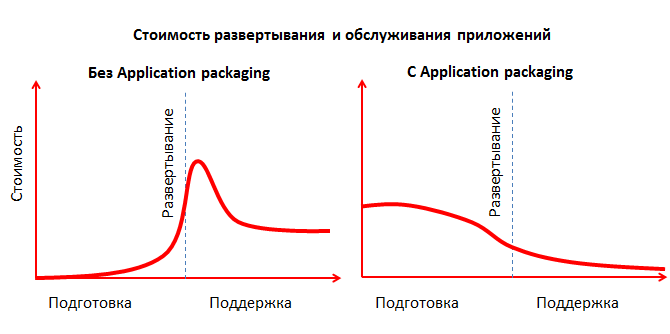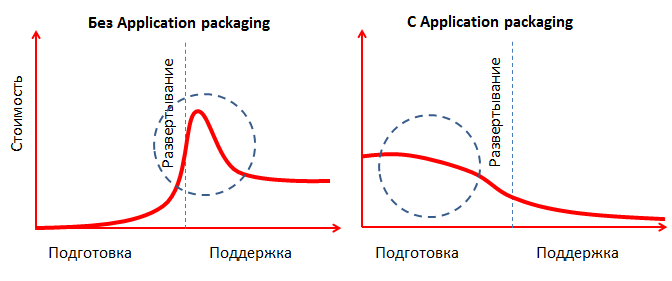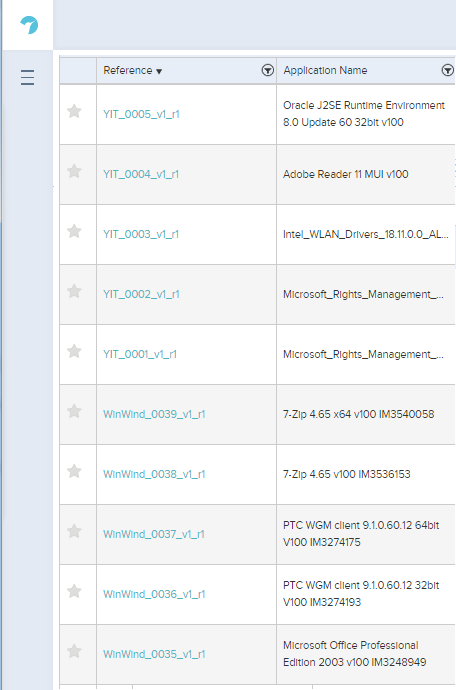Basics of preparing applications for deployment (Application packaging)

"Application packaging" is a well-established term for the name of an IT service in the field of end-user support (EUS) worldwide, but practically unknown in Russia. Therefore, in our article we describe the best practices that are hidden behind this service and describe how it can help reduce the total cost of ownership (TCO) of the software and, ultimately, reduce the cost of supporting user workplaces.
Strategy and approaches. Reduced TCO.
')
The cost of owning software (software) occupies a significant share of the IT budget of any modern company, which determines the relevance of management (approaches, strategy, etc.) of both the budget and programs in order to reduce the cost of supporting user workplaces. One of such time-tested approaches is Application packaging (Russian author's translation “Preparing Applications for Deployment”).
The result of preparing an application for deployment is a package containing one or more applications, containing all the necessary user, regional, licensing settings, if necessary, tuned to resolve known problems, including compatibility. As a rule, all packages have single interfaces (almost always the command line and sometimes UI) for installation and removal, which facilitates further operation for the Service Desk. It is also important to note that during the development of the package, corporate policies and best practices are applied. We will give the most popular examples, such as:
- Ability to install in silent mode (silent) in order not to distract the user from work.
- Disable updates to minimize traffic and control software versions used (and minimize the number of heterogeneous versions, which increases the cost of program maintenance)
- Installation is strictly without rebooting and shutting down the computer in order not to interrupt the work of end users, even in the most difficult situations when software developers require it.
- Automatic removal of previous software version at package level to minimize deployment efforts.
- And hundreds of other practices ...
Thus, the package incorporates all the best and implements the requirements already at the stage of its development, which further allows to abstract from the work requiring high qualification. Unified installation and removal interfaces make it possible to distance itself from the very essence of the “application”, easily replicating the installation / removal command to tens, hundreds and even thousands of clients (we have customers with tens of thousands of computers) using software deployment systems like Microsoft SCCM and other similar systems.
ROI (Return of investments)
Today, all the top Western companies use the practice of preparing applications for deployment (Application packaging) in their IT. Moreover, this service is standard for any large tender, which indicates the demand for these services, its relevance and economic feasibility.
For example, in the article JUKKA KOULETSIS: The Basics of Application Packaging gives the experience of Dell, which argues that the use of practices (service) for preparing programs for deployment allows you once to invest in the development and testing of the package, to reduce the cost of supporting them:

We would like to share the experience of our company and confirm the graphs in the article with the following examples.
In the manufacturing sector, we work with two companies (European divisions) that manufacture tires. These are world leaders (from TOP-10) with more than 10 thousand workstations. Only through the use of application packaging practices, we were able to bring the composition of the deployment team to 1 person (excluding backups). In other words, we were able to compensate 80% of the cost of preparing applications already at the deployment stage, while at the initial stage the number of incidents related to applications was reduced by 45%, respectively:

We observed similar dynamics with data of the same order when introducing services in the banking sector (two large European banks and their branches), two large companies from the construction industry and a number of other companies in the Scandinavian countries, which once again confirms the universality of practices.
Of course, specific schedules will depend both on the characteristics of the environment in which the package preparation approach is used and on the service provider, as service providers professionally involved in Application packaging have their own secrets and solutions, but in general, the feasibility of the practice preparing applications for deployment is obvious. For more than 8 years of working with foreign customers around the world, we have formed our secrets in the field of application management , which we are ready to apply to customers from Russia.
Technologies and Solutions
Today, for the corporate and private sectors, there is a huge variety of technologies and programs for preparing software for deployment.
The best-known technology is Microsoft Windows Installer, a Microsoft Windows subsystem that provides software installation in a special .msi format. Unlike uncontrolled and unmanaged setup.exe technology provides a number of advantages that make it extremely popular:
- the installation process can be controlled by standard Windows policies;
- information about installed programs is contained in a structured form (database) and cab archives, which ensures transparency (including for antiviruses);
- self-healing is possible if some resources are damaged, which reduces the number of incidents;
- the possibility of forced recovery, which reduces the time to restore the application, in the event of loss of integrity;
- the possibility of pre-detection of conflicts between applications and their elimination,
- etc.
A great many other advantages aimed at reducing the cost of software maintenance have made this technology the de facto standard in the corporate sector. Read more about the benefits of technology can be read here .
Therefore, in certain situations, it becomes advantageous to convert installation files of the Exe format (Setup.exe) into the Windows Installer format. For these purposes, we use the Adminstudio Repackager solution from Flexera Software .
Today, software virtualization technologies are becoming increasingly popular, in particular, Microsoft's AppV solution, to which we have dedicated a separate article on Habré. Virtualization technologies are gaining increasing popularity every year. Today, half of our major European customers use AppV as the main technology, while Windows Installer is used where AppV is not applicable. The latter is particularly beneficial where terminal environments are commonly used. For them, Application packaging by managing conflicts (proactive search and elimination) and proactive analysis of the possibility of using on terminal environments allows not only to get all the advantages described above, but also to make more efficient use of physical servers, reduce the number of rebild servers and the total number of incidents and problems , that is, reduce the cost of ownership up to 25% percent. For conflict management, we use our own development, as well as the Application Manager solution from Flexera Software .
Moreover, the use of services for the preparation of applications for deployment can significantly reduce the risks and cost of migrating to new environments (for example, from desktop solutions to terminal or new OS). So, now we are actively working on the migration of some of our clients to Windows 10. And for those customers who already use Application packaging - we do this work in a matter of weeks / months, depending on the size of the company. In the same place where Application packaging is not yet used, the migration time is the best period for implementing the service, while at the same time optimizing the composition of the software, which in fact can save only the migration budget at times, not to mention the further cost of support. About what programs are used to rationalize, just below in this material.
In the area of advanced software preparation, we have been working for many years with leading companies around the world, and during this period we have developed many of our solutions that allow us to be efficient and provide first-class service. Here are some of our solutions:
- Colibri tracker - the solution allows us to manage the process of preparing applications for deployment, as well as support projects for the migration of operating systems, applications, etc. In addition to tracking tasks (programs / packages) along the life cycle, this utility implements pipeline automation and integration with ITSM systems , deployment systems (SCCM / Altiris, etc.) and other software (including the ones presented in this article), which allows us to reduce time costs by 45% and offer optimal prices for our customers due to coherence, flexibility, synergy in work management: we also provide Colibri as a SaaS solution .
- Inventory Intelligence portal. To do something better, you must first understand "as is" now and think "where and what" can be rationalized. This program uses the results of the utilities for inventory (from Microsoft, Lakeside) and helps to carry out "intelligent" analysis :
- eliminate unused and forgotten software;
- exclude programs with the same purpose, making a choice in favor of the most optimal;
- understand where you can use fewer licenses than previously purchased or planned to purchase.

From our experience we can say that only about 20% of software covers 80% of the needs of any company. IIP helps us identify those 20% and concentrate on them in order to maximize the speed of migration projects to the new operating system and update the fleet of workstations by migrating the maximum number of users in a short time. - CaptureTool. This tool we offer our customers to simplify the collection of requirements for software and the formation of a document with the requirements : a set of settings during installation, after installation. The only thing that needs to be done is to launch the utility, click the “start” button, install the program, configure it, and click the “finish” button.

The user can add the generated document with specific requirements (wishes on the platform, etc.). In addition, if necessary, the program will scan the most important system logs, registry keys, schedule memory / processor (RAM / CPU). In the future, this information can be used to decide on the application delivery method (thin / thick client, the need for virtualization, deployment system or AD, etc.). - AppPortal is another solution that allows users to independently order programs that will be immediately delivered to the user on his computer. The result - users are happy, the minimum involvement of the support service (or rather the lack of time spent, except for the support of AppPortal itself).

The combination of third-party vendor solutions and our solutions allows us to provide high-level services even for mature IT infrastructures at an adequate cost.
Possessing significant experience in application management and in preparing applications for deployment, we use best practices not only when working with European customers, but also spread our experience to companies in our country. This article seems to be one of the first to describe the Application Packaging service in Russian, and we hope that it will have an impact on the popularization of knowledge in this field in Russia.
Source: https://habr.com/ru/post/266705/
All Articles